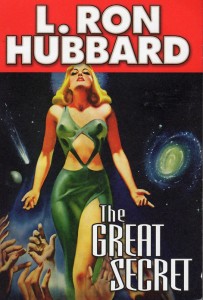Book Review: The Great Secret by L. Ron Hubbard
This is another in the line of Galaxy Press reprints of L. Ron Hubbard’s pulp magazine stories. As always, the physical presentation is excellent. This time, we have four short science fiction stories. The cover doesn’t actually apply to any of them.
“The Great Secret” is focused on Fanner Marston, the sole survivor of an expedition to find a lost city of the great star-spanning civilization that once ruled the universe. Hidden in that city is the Great Secret that gave them mastery–once Marston learns it he will be all-powerful and able to rule the current civilization. His single-minded focus allows him to ignore pain, starvation and thirst to some degree. At last he finds the lost city and learns the Great Secret. What is it? Sorry, spoilers.
“Space Can” is set during the war between the Terrans and the Saturnians. A small battleship is sent to check up on a report that shipping is being attacked. It turns out that the situation is much worse than advertised, but there’s no time for the Menace to wait for backup. The brave officers and men are outnumbered and outgunned, but perhaps they can pull it off. The theme of the story is the anthropomorphic way the crew relates to their ship–with the possibility that the ship reciprocates.
It’s worth noting that we learn almost nothing about the war; the Saturnians have pointy heads, but are otherwise not characterized. For all we know, the Terrans are invaders wiping out the peaceful folk of Saturn.
“The Beast” is a jungle adventure story transplanted to Venus. Great white hunter Ginger Cranston is called upon by the native “blues” when “da juju” starts killing people. At first he’s baffled by the cunning unseen monster, and spends much of the story in a funk due to an early defeat. Period racism is on display here, even if thinly disguised by making the superstitious natives aliens. Apparently they still have segregation in the future. The ending twist is fairly obvious a couple of pages in.
“The Slaver” is set in a future where Earth has been defeated by the forces of Lurga. They apparently just destroyed its military and spacefaring capabilities, but didn’t bother occupying the world. Instead, the Earth people have reverted to a semi-feudal social structure, and suffer slaving raids by the Lurgans.
On this particular trip, the Lurgan slavers have picked up Kree Lorin, a young lord, as well as the usual peasants. Kree had been haughty, and his courtship of the lovely Dana of Palmerton had been based on him elevating her social status, which she had refused. (There’s a sexist slur word used towards her mother.) Now they are chained next to each other on the slave ship Gaffgon, captained by the obese and cruel Voris Shapadin. When Voris decides to sample the merchandise early by taking Dana to his cabin, this gives Kree the motivation to fight for his (and Dana’s) freedom. The other peasants? Forgotten.
Some readers may find the “She rejected me, but when I save her from the much worse guy, she’ll be grateful and love me” plotline a bit obnoxious.
There’s a helpful glossary, but it’s been combined with that for the next book in the series, The Professor Was a Thief, so some of the entries don’t make sense in this volume. There’s a short preview of that story, and the usual potted biography of Mr. Hubbard.
This is midlist pulp SF, enjoyable but no great shakes. Check your local library or used book sales; it really is an attractive book.

